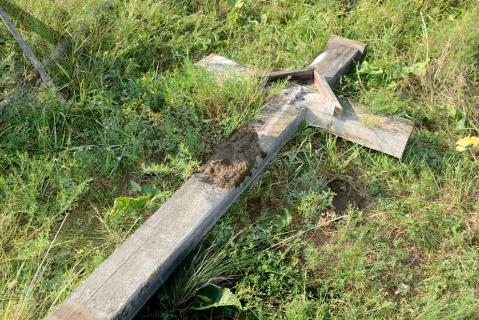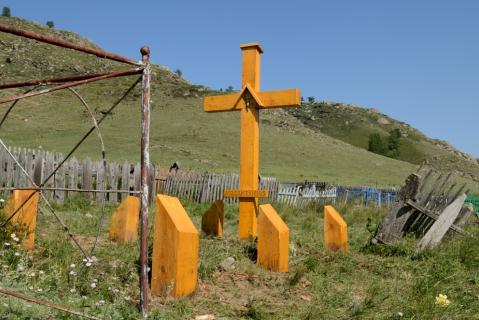In 1941, in response to the 16 May 1941 Politburo resolution, deported Lithuanians were allocated to the Kara-Koba village in the Ongudaisky district. Their exact number is unknown. The adults worked in the fields, logging timber and in a vegetable-growing State farm. Those who died were buried according to Catholic rites in a separate section of the graveyard, with headboards on their graves. The total numbers who died have not been established.
In 1990, former deportees and their relations visited the graveyard. They put up a wooden commemorative cross there, bearing the name plate “Kazakevicius”, surrounded by small posts (no longer extant), each decorated with a crucifix. In 2011, Lithuanian researcher Gintautas Alekna studied the graveyard and carried out a photo survey. In August 2012, members of the “Destination, Siberia” youth expedition from Lithuania worked in the graveyard. They cleared the territory and prepared and installed a new wooden cross to replace the now dilapidated 1990 cross.
Research on the Genocide of the Lithuanian People (Lietuvos gyventoju Genocidas; 3 vols. 1999-2009) contains about 130,000 biographical entries (in Lithuanian). Vol. 3 covers the years from 1948 onwards and see Deportation of Lithuanians, 1941-1951 for the 29 other burial grounds and commemorative sites on the Map of Memory.
The Memorial online database (2025) lists 7,379 victims in the Altai Republic (see Gorno-Altaisk).
The republic’s Book of Remembrance includes 11 Lithuanians.
| State of burials | Area | Boundaries |
|---|---|---|
|
One headboard has survived
|
not defined
|
not delineated
|
[ original texts and hyperlinks ]
Note on the 1991 expedition by the Genocide and Resistance Research Centre of Lithuania
“Ekspedicija Altajus 2012”, Lemtis (Destiny) association website (in Lithuanian)
G. Alekna, “Ekspedicija 2012. Altajus Kara Koba” (YouTube film) retrieved 26 May 2022


